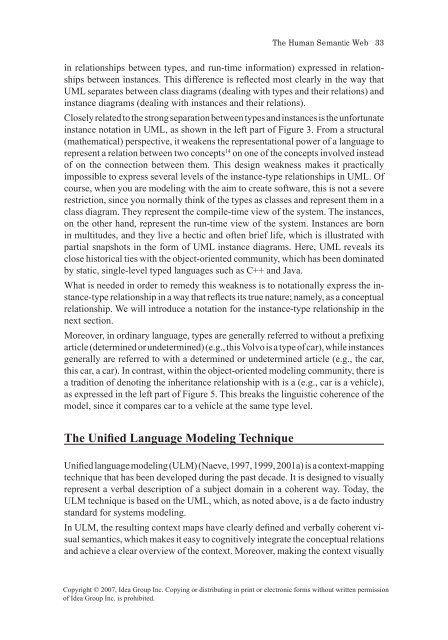Semantic Web-Based Information Systems: State-of-the-Art ...
Semantic Web-Based Information Systems: State-of-the-Art ...
Semantic Web-Based Information Systems: State-of-the-Art ...
Create successful ePaper yourself
Turn your PDF publications into a flip-book with our unique Google optimized e-Paper software.
The Human Semant c <strong>Web</strong><br />
in relationships between types, and run-time information) expressed in relationships<br />
between instances. This difference is reflected most clearly in <strong>the</strong> way that<br />
UML separates between class diagrams (dealing with types and <strong>the</strong>ir relations) and<br />
instance diagrams (dealing with instances and <strong>the</strong>ir relations).<br />
Closely related to <strong>the</strong> strong separation between types and instances is <strong>the</strong> unfortunate<br />
instance notation in UML, as shown in <strong>the</strong> left part <strong>of</strong> Figure 3. From a structural<br />
(ma<strong>the</strong>matical) perspective, it weakens <strong>the</strong> representational power <strong>of</strong> a language to<br />
represent a relation between two concepts 14 on one <strong>of</strong> <strong>the</strong> concepts involved instead<br />
<strong>of</strong> on <strong>the</strong> connection between <strong>the</strong>m. This design weakness makes it practically<br />
impossible to express several levels <strong>of</strong> <strong>the</strong> instance-type relationships in UML. Of<br />
course, when you are modeling with <strong>the</strong> aim to create s<strong>of</strong>tware, this is not a severe<br />
restriction, since you normally think <strong>of</strong> <strong>the</strong> types as classes and represent <strong>the</strong>m in a<br />
class diagram. They represent <strong>the</strong> compile-time view <strong>of</strong> <strong>the</strong> system. The instances,<br />
on <strong>the</strong> o<strong>the</strong>r hand, represent <strong>the</strong> run-time view <strong>of</strong> <strong>the</strong> system. Instances are born<br />
in multitudes, and <strong>the</strong>y live a hectic and <strong>of</strong>ten brief life, which is illustrated with<br />
partial snapshots in <strong>the</strong> form <strong>of</strong> UML instance diagrams. Here, UML reveals its<br />
close historical ties with <strong>the</strong> object-oriented community, which has been dominated<br />
by static, single-level typed languages such as C++ and Java.<br />
What is needed in order to remedy this weakness is to notationally express <strong>the</strong> instance-type<br />
relationship in a way that reflects its true nature; namely, as a conceptual<br />
relationship. We will introduce a notation for <strong>the</strong> instance-type relationship in <strong>the</strong><br />
next section.<br />
Moreover, in ordinary language, types are generally referred to without a prefixing<br />
article (determined or undetermined) (e.g., this Volvo is a type <strong>of</strong> car), while instances<br />
generally are referred to with a determined or undetermined article (e.g., <strong>the</strong> car,<br />
this car, a car). In contrast, within <strong>the</strong> object-oriented modeling community, <strong>the</strong>re is<br />
a tradition <strong>of</strong> denoting <strong>the</strong> inheritance relationship with is a (e.g., car is a vehicle),<br />
as expressed in <strong>the</strong> left part <strong>of</strong> Figure 5. This breaks <strong>the</strong> linguistic coherence <strong>of</strong> <strong>the</strong><br />
model, since it compares car to a vehicle at <strong>the</strong> same type level.<br />
The Unified Language Modeling Technique<br />
Unified language modeling (ULM) (Naeve, 1997, 1999, 2001a) is a context-mapping<br />
technique that has been developed during <strong>the</strong> past decade. It is designed to visually<br />
represent a verbal description <strong>of</strong> a subject domain in a coherent way. Today, <strong>the</strong><br />
ULM technique is based on <strong>the</strong> UML, which, as noted above, is a de facto industry<br />
standard for systems modeling.<br />
In ULM, <strong>the</strong> resulting context maps have clearly defined and verbally coherent visual<br />
semantics, which makes it easy to cognitively integrate <strong>the</strong> conceptual relations<br />
and achieve a clear overview <strong>of</strong> <strong>the</strong> context. Moreover, making <strong>the</strong> context visually<br />
Copyright © 2007, Idea Group Inc. Copying or distributing in print or electronic forms without written permission<br />
<strong>of</strong> Idea Group Inc. is prohibited.


